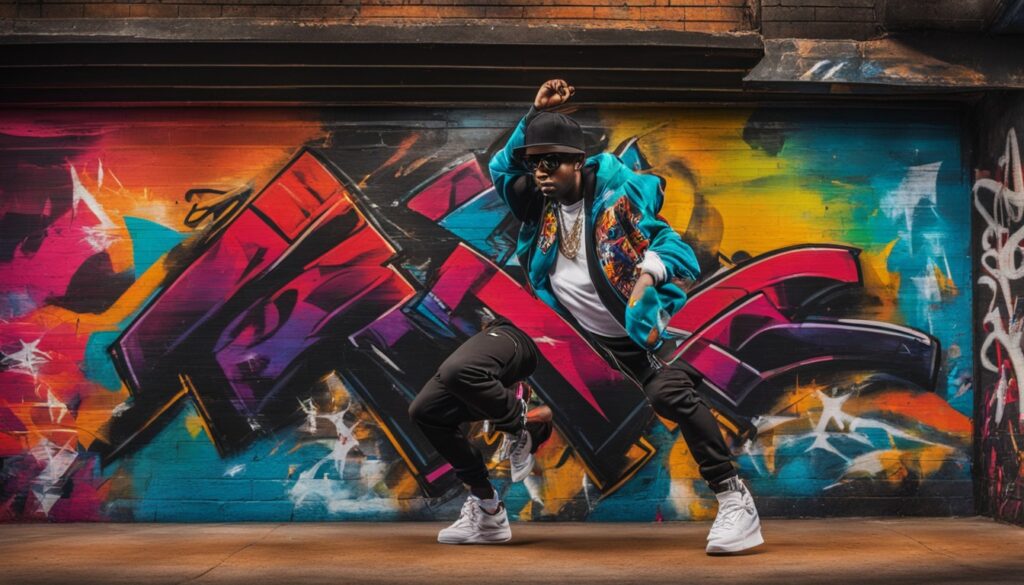In 2017, Luis Fonsi released “Despacito” and it quickly became a hit. This song, with its catchy tune and deep lyrics, touched hearts around the world. But what’s the deeper meaning? One morning in 2015, Fonsi had a sudden idea for the song. He recorded the bilingual lyrics and a melody piece right away. He knew this song had something special, so he worked with Erika Ender. Together, they made a track that mixed urban and Latin pop smoothly.
The song really took off with Daddy Yankee’s addition. His reggaeton style made the song authentic. Released on May 27, 2017, it zoomed to the top of the Billboard Hot 100. It stayed number one for 16 weeks, tying with a record by Mariah Carey and Boyz II Men. Then, a remix with Justin Bieber helped it gain worldwide fame. Thanks to this, “Despacito” became a big name in Latin and global music.
Key Takeaways
- Luis Fonsi’s inspiration for “Despacito” began with a simple, morning epiphany in 2015.
- The integration of Erika Ender’s songwriting and Daddy Yankee’s reggaeton expertise was pivotal to the song’s success.
- “Despacito” held the No. 1 spot on the Billboard Hot 100 for 16 consecutive weeks.
- The song’s remix featuring Justin Bieber played a significant role in its global appeal.
- With over 9 billion streams on Spotify and YouTube combined, “Despacito” remains a record-breaking hit.
- The music video for “Despacito” is the second most-watched YouTube video of all time.
- The song markedly influenced the mainstream acceptance of Latin pop and reggaeton genres.
Introduction to “Despacito”
“Despacito” means “slowly” in Spanish. This reflects the song’s theme about a slow, sensual romantic encounter. The Despacito origin is rooted in Puerto Rico’s vibrant music scene. Luis Fonsi and Daddy Yankee, both from Puerto Rico, worked together on this song. Their collaboration brought an authentic Latin feel to it, sparking a worldwide interest in Spanish pop music.
The song’s title, “Despacito,” captures the essence of wanting a slow and vivid romance. It hit number one on the Billboard Hot 100, the first Spanish song to do so since 1996. It also stayed at the top for 16 weeks. “Despacito” became a hit in 47 countries and made the top 10 in six more.
The song didn’t just top charts; it also won four Grammy Awards in 2017. “Despacito” was the first Latin song to get a diamond certification from the RIAA. The music video, shot in La Perla in Old San Juan and La Factoría bar, helped make it a cultural icon.
Its official music video hit over four billion views on YouTube. This made it the most-watched video from August 2017 to November 2020. Justin Bieber’s remix in April 2017 boosted its popularity, especially in English-speaking countries. In 2017, it was the most streamed song, with 4.6 billion plays. “Despacito” remains a favorite worldwide.
The mix of Spanish and English in “Despacito” reached a large audience, making it a standout hit. It broke records, including a 56-week reign on the Hot Latin Songs chart. It was the first primarily Spanish song to lead the Billboard Hot 100 since “Macarena” in 1996. This song truly made history.
The Origins of “Despacito”
Luis Fonsi and Erika Ender teamed up to create “Despacito”. They wanted to make a song that would be a hit in urban music scenes. What started as a cumbia and pop mix turned into a smash reggaeton and Latin pop hit.
Creation of the Song
Luis Fonsi and Erika Ender worked hard on “Despacito”. They were careful to write lyrics that respected women. This care made the song very popular.
“Despacito” topped the Billboard Hot 100 chart for sixteen weeks in summer 2017. It tied the record with Mariah Carey and Boyz II Men’s “One Sweet Day.” The song’s video was the most watched on YouTube when it came out on January 13, 2017. On Spotify’s global chart, it reached #3, a big achievement for a Spanish song.
Collaboration with Daddy Yankee
Daddy Yankee teamed up with Luis Fonsi and added a reggaeton vibe. This mix attracted many fans. Their music hit #2 on the Hot Latin Songs chart, then #1 in three weeks.
The use of the cuatro, a Puerto Rican instrument, made “Despacito” stand out. The remix with Justin Bieber pushed it to #1 on the Billboard Hot 100 fast. This remix blended different music styles effectively.
“Despacito” marked a big win for Spanish songs worldwide. The team-up between Luis Fonsi and Daddy Yankee was memorable. They received Grammy nods and Latin Grammy awards, showing their global appeal.
Despacito Meaning: Analyzing The Lyrics
“Despacito” is about the thrill of a growing romantic relationship. It mixes eagerness with respect. The Spanish lyrics use vivid images and metaphors to show how two lovers connect. The chorus slows down carefully, echoing the song’s title, “Despacito,” which means “slowly.” This mix of lyrics and music has made it hugely popular, with billions of streams. It topped the Billboard Hot 100 chart for 16 weeks.
Spanish Lyrics Breakdown
The Despacito Spanish meaning is shown through beautiful, poetic lines. They explore love and desire. For example, “Vamo’ a hacerlo en una playa en Puerto Rico” means “Let’s do it on a beach in Puerto Rico.” These lines create strong feelings in listeners. Yet, the song’s explicit romantic themes have stirred controversy. This led to its ban in Malaysia. Private radio stations there even censored the song.
English Translation Insights
The Despacito English translation lets more people understand its depth. The English lines show different levels of longing. They keep the song’s sensual feel. For instance, “I want to breathe your neck slowly” is very evocative. Getting the translation right is important. Google Translate does well here, with a score of 9.6. It beats other tools in capturing the song’s subtle meanings. This ensures the Despacito lyrics meaning is kept intact across cultures.
| Machine Translation Engine | Accuracy Score |
|---|---|
| Google Translate | 9.6 |
| Microsoft Translator | 8.5 |
| Most Popular on MachineTranslation.com | 8.5 |
The remix with Justin Bieber shows how well cross-cultural projects can work. It has brought the song to fans outside reggaeton and Latin pop. The careful translation and musical skill make “Despacito” an intriguing case in global music.
The Cultural Impact of “Despacito”
“Despacito” by Luis Fonsi and Daddy Yankee changed the music world hugely. It’s the most-streamed video on YouTube, with over 8.5 billion views. This song topped the Billboard Hot 100 for 16 weeks. It introduced many to Latin music’s vibrant spirit through its catchy tune and lyrics.
“Despacito” has deep cultural significance. It was the first Latin song to get Diamond certification from the RIAA. This means it had over 10 million sales and streams in the U.S. Its success highlighted the creativity of Latin artists. It also increased tourism in Puerto Rico by 45% because of its beautiful music video locations.
The song became popular in many communities. It turned into football anthems in Argentina, Brazil, and Korea. Despite its universal appeal, it faced bans, like from the Malaysian government. This shows how “Despacito” reached various cultures and places.
Latin music’s presence grew after “Despacito.” In 2017, 19 Spanish tracks hit the Billboard Hot 100. This number increased to 41 by 2020, thanks to artists like Bad Bunny. “Despacito” helped Latin music get into mainstream radio. It led to many collaborations between Latin and mainstream artists. Now, Spanish music is the second most consumed after English. This proves the global appeal of Latin rhythms.
FAQ
What is the meaning of “Despacito” by Luis Fonsi?
“Despacito” means “slowly” in Spanish, highlighting the song’s focus on a slow and sensual romance. It explores passion and respect in a love affair. The lyrics capture the essence of a deepening relationship.
Who collaborated with Luis Fonsi in creating “Despacito”?
Luis Fonsi worked with Erika Ender on “Despacito,” blending urban and Latin pop. Daddy Yankee added reggaeton authenticity. This was key for the song’s massive success.
What inspired Luis Fonsi to create “Despacito”?
In 2015, Luis Fonsi got a sudden inspiration for “Despacito.” He recorded a melody and some lyrics. Fonsi and Erika Ender turned this idea into a global hit.
How does “Despacito” translate in English?
“Despacito” translates to “slowly” in English. This reflects the song’s emphasis on a gradual, sensual love development.
What is the significance of the Spanish lyrics in “Despacito”?
The Spanish lyrics use vivid images and metaphors, focusing on the bond between lovers. They offer a deeper look into the song’s story.
What impact has “Despacito” had on global music?
“Despacito” became more than a hit; it’s a cultural milestone. It topped charts worldwide. It made Latin music more popular globally and inspired other artists.
How did the collaboration with Daddy Yankee influence “Despacito”?
Daddy Yankee added a genuine reggaeton vibe to “Despacito.” This mix of melody and rhythm helped make the song a global phenomenon.
What can English-speaking audiences learn from the translated lyrics of “Despacito”?
English speakers can understand love and desire better through “Despacito”. Luis Fonsi’s deliberate language choices convey deep emotions, urging listeners to look beyond the beat.
What role did Erika Ender play in the creation of “Despacito”?
Erika Ender co-wrote “Despacito” with Luis Fonsi. They focused on a mix of sounds and respectful lyrics, falling in line with modern music trends.
Why is “Despacito” considered a milestone in Latin music?
“Despacito” marked a new era in Latin music, captivating a global audience. Its universal appeal broke language and cultural barriers, showcasing music’s unifying power.



